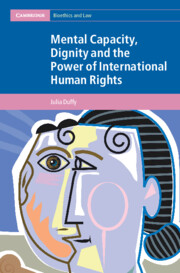138 results
3 - Fitting in by Decree
-
-
- Book:
- Freed Persons in the Roman World
- Published online:
- 16 May 2024
- Print publication:
- 23 May 2024, pp 86-118
-
- Chapter
- Export citation
Dignity-related distress and recall among alert, non-delirious critically ill patients
-
- Journal:
- Palliative & Supportive Care , First View
- Published online by Cambridge University Press:
- 13 May 2024, pp. 1-5
-
- Article
-
- You have access
- Open access
- HTML
- Export citation
Some Challenges for Moreau's Theory of Wrongful Discrimination
-
- Journal:
- Dialogue: Canadian Philosophical Review / Revue canadienne de philosophie / Volume 63 / Issue 1 / April 2024
- Published online by Cambridge University Press:
- 23 April 2024, pp. 21-29
-
- Article
-
- You have access
- Open access
- HTML
- Export citation
Chapter 5 - Privacy and Dignity in Acute Hospitals
-
-
- Book:
- Handbook of Old Age Liaison Psychiatry
- Published online:
- 04 April 2024
- Print publication:
- 11 April 2024, pp 59-69
-
- Chapter
- Export citation
10 - Sufficiency re-examined
- from Part II - Inclusiveness, Social and Individual Agency
-
-
- Book:
- Social Choice, Agency, Inclusiveness and Capabilities
- Published online:
- 28 March 2024
- Print publication:
- 14 March 2024, pp 222-239
-
- Chapter
- Export citation
8 - The Rhetoric of Assisted Suicide and Euthanasia (‘Medical Assistance in Dying’)
-
- Book:
- Practical Ethics in Suicide
- Published online:
- 15 February 2024
- Print publication:
- 22 February 2024, pp 131-166
-
- Chapter
- Export citation
12 - Culture, Precarity, and Dignity
-
-
- Book:
- Diversity and Precarious Work During Socio-Economic Upheaval
- Published online:
- 01 February 2024
- Print publication:
- 08 February 2024, pp 240-263
-
- Chapter
- Export citation
My Body Is My Temple? Comparing Sexual Crimes and Property Crimes in a Human Rights Tradition – ERRATUM
-
- Journal:
- German Law Journal / Volume 25 / Issue 1 / February 2024
- Published online by Cambridge University Press:
- 26 January 2024, p. 152
-
- Article
-
- You have access
- Open access
- HTML
- Export citation
My Body Is My Temple? Comparing Sexual Crimes and Property Crimes in a Human Rights Tradition
-
- Journal:
- German Law Journal / Volume 25 / Issue 1 / February 2024
- Published online by Cambridge University Press:
- 15 January 2024, pp. 1-16
-
- Article
-
- You have access
- Open access
- HTML
- Export citation
9 - Objective and Subjective Dimensions of Meaningful Waged Work
- from Part III - Meaningful and Meaningless Waged Work
-
- Book:
- The Politics of Working Life and Meaningful Waged Work
- Published online:
- 02 November 2023
- Print publication:
- 16 November 2023, pp 179-230
-
- Chapter
- Export citation
5 - Article 12 and Dignity
-
- Book:
- Mental Capacity, Dignity and the Power of International Human Rights
- Published online:
- 03 August 2023
- Print publication:
- 17 August 2023, pp 151-195
-
- Chapter
- Export citation
Chapter 18 - Of Origin and Opportunity
- from Part III - Readings in Genre, Gender, and Genealogies
-
-
- Book:
- Diaspora and Literary Studies
- Published online:
- 20 July 2023
- Print publication:
- 10 August 2023, pp 314-328
-
- Chapter
- Export citation

Mental Capacity, Dignity and the Power of International Human Rights
-
- Published online:
- 03 August 2023
- Print publication:
- 17 August 2023
8 - Rousseau and Kant
-
- Book:
- Modern Moral Philosophy
- Published online:
- 10 June 2023
- Print publication:
- 15 June 2023, pp 269-342
-
- Chapter
- Export citation
22 - Care
- from Part IV - Intimate and Everyday Life
-
-
- Book:
- The Cambridge Handbook for the Anthropology of Ethics
- Published online:
- 11 May 2023
- Print publication:
- 25 May 2023, pp 561-590
-
- Chapter
- Export citation
A survey inquiry into behavioral foundations of hate speech regulations: evidence from Japan
-
- Journal:
- Japanese Journal of Political Science / Volume 24 / Issue 1 / March 2023
- Published online by Cambridge University Press:
- 19 April 2023, pp. 101-117
-
- Article
- Export citation
2 - Conceptual Approaches to Data Protection in the European Union and the United States
-
- Book:
- Transatlantic Jurisdictional Conflicts in Data Protection Law
- Published online:
- 06 April 2023
- Print publication:
- 13 April 2023, pp 18-32
-
- Chapter
- Export citation
Dignity, Dementia and Death
-
- Journal:
- Kantian Review / Volume 28 / Issue 2 / June 2023
- Published online by Cambridge University Press:
- 30 March 2023, pp. 221-237
- Print publication:
- June 2023
-
- Article
-
- You have access
- Open access
- HTML
- Export citation
2 - Respect, Esteem, and Solidarity
-
- Book:
- Democratic Respect
- Published online:
- 16 March 2023
- Print publication:
- 23 March 2023, pp 49-86
-
- Chapter
- Export citation



